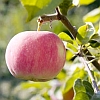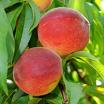Home Garden Fruit Trees in Arkansas
 Careful planning, preparation, and care of fruit trees are critical for success. Attention
must be given to variety selection, site selection, rootstock selection, weed control,
irrigation, fertilization, and pest management.
Careful planning, preparation, and care of fruit trees are critical for success. Attention
must be given to variety selection, site selection, rootstock selection, weed control,
irrigation, fertilization, and pest management.
Recommended fruit trees for Arkansas home gardens:
![]() apples
apples
![]() pears
pears
Apples and pears are much more forgiving, especially if you are willing to eat a fruit that is not 100% blemish free.
The stone fruits (peaches, nectarines, and plums) are more difficult to grow in the home garden due to their pest susceptibility. Peach trees are the hardest to grow in Arkansas.
Less common fruit trees that don’t require spray programs:
- figs
- pawpaw
- persimmons
- jujube trees
Fig Trees
Fig trees should not be planted until early spring. Figs are self-fruitful and will bear fruit on new growth. Plant them in a more protected spot where they still get at least 6-8 hours of sunlight—a sunny area near your house is good, but be aware that figs can produce a lot of fruit.
If you don’t harvest regularly the fruits can split and attract wasps, bees and flies so keep them away from entryways or patio areas. Brown Turkey (also called Texas Everbearing) and Celeste are the most common varieties available, but there are many more you can try. Nero, Blanche (also called White Russian) and Conardia are a few others.
Read more about growing figs in Arkansas.
Pawpaws
Pawpaws are a native tree with a very unusual fruit. They have been gaining in popularity. The trees tend to be more upright in growth habit and can get 12-20 feet tall. They have large, almost tropical looking leaves with a maroon bloom.
Pollinating pawpaw flowers can be a challenge. Although the flowers contain both male and female parts, the female part matures before the pollen is ready in each bloom. They therefore need two different trees to get pollination and bees show no interest in pawpaw flowers. Flies and beetles are the pollinators, or you can hand pollinate, using a small, soft brush to transfer pollen to the stigma. The resulting fruit can be quite large.
Pawpaw fruit ripens between mid-August and into October, depending on the weather. When ripe, it is soft and yields easily to a gentle squeeze. The skin of the green fruit usually lightens in color as it ripens and often develops blackish splotches which do not affect the flavor. The yellow flesh is custard like often described as a custard banana.
Pawpaws don’t last long once they are picked, so they will never be commercially available, since they wouldn’t last long enough to ship. If you can get to them before the squirrels and raccoons, eat them within two to three days.
Read more about growing Pawpaw trees in Arkansas.
Persimmons
Our native persimmon does produce edible fruit—provided you eat them after a frost, they are not the showiest tree for the home landscape. A better choice would be one of the oriental persimmons. Oriental persimmons fruit ripens from late August until early December, depending on the variety and weather conditions.
Some varieties are self-fruitful and others require two varieties for pollination. Fuyu-Gaki persimmon is the most widely planted self-fruitful cultivar in the world. When fully ripe, this fruit turns a crimson red with a blue blush. Other self-fruitful varieties include Gionbo with very large (4-5") orange conical, astringent fruits, Great Wall, and Matsumoto.
Most oriental persimmon trees grow about 15 feet tall and wide. They are disease and insect free for the most part, requiring a little thinning in the spring, and water and fertilization.
Read more about growing persimmons in Arkansas.
Jujubes
Probably the least known, but easily grown home fruit is the jujube or Arkansas date - Ziziphus jujube. Native to China, the jujube is a small, deciduous tree, growing to 25- 35 feet tall. The tree does have some thorns on the branches, but overall it has a graceful, drooping growth habit with branches growing in a zig-zag pattern. The greenish-white flowers are small but fragrant, and produced in large numbers from late spring into early summer.
Most jujube cultivars are self-fruitful but will produce better with two trees. The fruits can vary from round to elongate and from cherrysize to plum-size depending on the cultivar. They have thin, edible skin surrounding whitish flesh similar to a date and are a mahogany color when ripe. It has one stone inside which contains two seeds. When fully ripe, the fruit begins to soften and wrinkle. Jujube fruit are edible either fresh, dried or preserved in sugar or honey syrups.
Jujube trees are extremely drought tolerant and have no pest problems. They are also winter hardy statewide, and rarely suffer from any late frost damage, since they bloom later in the season.
Variety Selection
When choosing fruit tree varieties, look for smaller varieties that can fit into a yard, and something that is fire blight resistant. Fire blight is a bacterial disease. There are sprays that can help to prevent it, but they aren’t fool-proof. Resistant varieties are available for many problems, and while resistance doesn’t mean you will never have a disease or insect, they definitely help.
The two most disease resistant varieties for apples for Arkansas are William’s Pride and Enterprise. For pears try Harrow Delight, Maxine, Kiefer, Magness and Moonglow.
View complete list of recommended varieties
Fruit trees other than figs, could be planted in the fall, but often the best variety availability will be in late winter.
The type of fruit tree, the age of the fruit trees you buy, and their vigor can determine production. Dwarf trees come into production sooner than standard, large trees. Most fruit trees can take up to 3-8 years to begin full production.
Site Selection
Before you buy a tree or two, consider the site. Make sure you have ample sunlight and space. Good drainage is critical, and you need at least 6-8 hours of sunlight a day. Water will be needed, so access to water is important. Then think of air drainage—if you plant fruit trees in a low spot in the yard, that would be a frost pocket, and late frosts can take a fruit crop. Planting on a slope or elevated area improves the air flow and helps with frost protection. Weeds and grass steal light, water and nutrients from your trees.
Publications
 Apples
Apples
| Number | Title |
|---|---|
| FSA6042 | Pruning Fruit Trees |
| FSA6058 | Apple Production in the Home Garden |
| FSA6129 | Tree Fruit Cultivar Recommendations for Arkansas |
| FCS499 | Arkansas Fresh: Apples |
| Recommended Apple Varieties for Arkansas |
Commercial Apple Tree Production Farm & Ranch | Arkansas Extension
 Pears
Pears
| Number | Title |
|---|---|
| FSA6042 | Pruning Fruit Trees |
| FSA6059 | Pear Production in the Home Garden |
| FSA6129 | Tree Fruit Cultivar Recommendations for Arkansas |
| Recommended Pear Cultivars |
Commercial Pear Tree Production Farm & Ranch | Arkansas Extension
 Nectarines & Peaches
Nectarines & Peaches
Commercial Nectarine & Peach Tree Production Farm & Ranch | Arkansas Extension
Licensed Propagators - University of Arkansas Patented Nectarine & Fresh-Market Peaches
 Insect Control
Insect Control
Insect Control for Fruits, Nuts, Vegetables Pest Management | Farm & Ranch | Arkansas Extension
Arkansas Insect Pest Photo Gallery Research & Extension | Division of Agriculture | University of Arkansas System
 Disease Control
Disease Control
Disease Control for Fruit & Nut Trees Pest Management | Farm & Ranch | Arkansas Extension
Plant Health Clinic Pest Management | Farm & Ranch | Arkansas Extension
Plant Disease Image Library Yard & Garden | Arkansas Extension
Department of Plant Pathology Bumpers College | University of Arkansas at Fayetteville
 IPM Resources
IPM Resources
| Number | Title |
|---|---|
| FSA2118 | Understanding Soil Test Results |
| FSA6132 | Foliar Sampling for Fruit Crops |
| FSA7503 | Home Fruit Orchard Sprays |
| FSA7534 | Fireblight of Ornamental Pear |
Soil Testing & Research Laboratory (Marianna) Arkansas Agricultural Experiment Station

